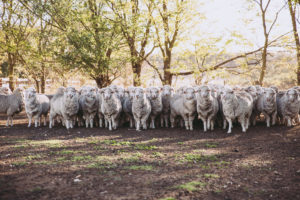Animal Health Australia (AHA) coordinates industry-funded projects to manage Johne’s (pronounced “Yo-nees”) disease (JD) in sheep, cattle, goats and alpaca.
Our projects work to protect Australia’s favourable JD status and reduce the impacts of the disease and its control measures on the livestock industries.
What is Johne’s disease?

JD is a wasting disease that affects various species of animals. In Australia, JD has been found in cattle, sheep, goats, deer and camelids. JD infections are caused by the bacterium, Mycobacterium avium spp paratuberculosis, which lives mainly in animal intestines, but can survive in the environment for several months.
JD bacteria affect animals by causing a thickening of the intestinal wall resulting in a reduction in the normal absorption of food. The infected animal is hungry and eats, but cannot absorb any nutrients. This results in wasting and finally death. Diarrhoea and bottle jaw are also common signs in cattle.
A number of strains of M. paratuberculosis have been identified and it is recognised that they are all capable of infecting a number of ruminant species.
Johne’s disease in Australia
Australia is in the fortunate position of having relatively little Johne’s disease compared to most developed agricultural countries. Large areas pf Australia have minimal to no Johne’s disease, and some of Australia’s livestock populations have no known infection.
Australians are actively involved in international organisations (see International Colloquium on Paratuberculosis) and research dealing with Johne’s disease (see the University of Sydney Johne’s disease website).
AHA manages the National Johne’s Disease Project (NJDP), a cooperative initiative of the Australian livestock industries, governments and veterinarians.
The NJDP aims to assist the livestock industries reduce the spread and impact of Johne’s disease in Australia.
Managing Johne’s disease in livestock involves:
- limiting its spread between areas and properties
- reducing the impact in affected animal groups.
The NJDP coordinates activities in market assurance, disease management, research, diagnostic methods and communication.
The main components of the NJDP are listed below.
Market assurance programs
Market assurance programs (MAPs) for cattle, sheep, goats and alpacas are a key strategy in the control of Johne’s disease.
Voluntary MAPs enable producers to identify and promote their JD status to clients.
Industry can minimise the spread of JD by sourcing replacement animals from animal groups (herds or flocks) assessed under the current MAPs.
National Standard Definitions, Rules and Guidelines (SDR&Gs)
The standard definitions and rules for ovine Johne’s disease are the agreed national standards for the disease management program.
Standard Diagnostic Procedures for Johne’s Disease
Maintenance of high quality techniques for diagnosis of Johne’s disease is a critical component of the NJDP.
The initial National JD Control Program Management (NJDCP) Committee developed the Australian and New Zealand Standard Diagnostic Procedures for Johne’s disease (ANZSDPs) to describe tests that are approved for use in Australia. Previously the Sub-Committee on Animal Health Laboratory Standards (SCAHLS) maintained the ANZSDPs.
The ANZSDP for Johne’s disease identifies and describes laboratory methods that assist in detecting and diagnosing Johne’s disease in susceptible domestic ruminant species.